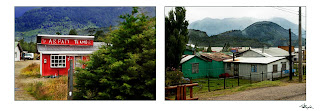For details, click on any image...
 |
| It's 291 nautical miles from Montt to our second stop at Chacabuco south through the Golf of Corcovado. |
 |
| It's about a day and a half by ship between the red pins. |
Puerto Chacabuco is a relatively new port city. In 1991 a savage wilderness fire and the eruption of nearby Mount Hudson volcano silted the Aisén river and blocked access to Puerto Aisén which caused the construction of a new port in the sleepy village of Chacabuco some 10 miles south of Aisén. Transition's fattening up Chacabuco and its population of 1,243.
However, the town's location along the far side of the Aisén river is magnificent.
 |
| At sunrise on Tuesday 1/22/19 we awoke to this view from our balcony on the ship's port side with Chacabuco visible (below) from the starboard. |
 |
| Joe & Mary Mayberry, Gib & Marti Armstrong and my wife Rita model Chacabuco January mid-summer fashions. BTW, that's our Norwegian Sun anchored to the right. |
 |
| On the other side of the river from the image above, Chacabuco sits in a river valley and is beginning to sprawl as a result of its replacement of Aisén in 1991 as the region's major port. |
 |
| As you can see, the topography is rugged and mountainous. Our bus had an ancient low gear which left us expecting to push. |
Generally the people are NOT poor. Rather they live in tidy, secure, and comfortable structures in a rocky countryside dotted by small livestock farms. NOTE the canted metal roofs in all of the structures above. Why? Tons of snow of course. Note also the lack of foundation shrubbery which is always destroyed by the collapse of snow upon them from those roofs. This is a challenging place in winter.
The last President of Chilé kicked off an expensive (and not overwhelmingly popular) series of national parks. One of the newest is the Parque National Rio Simpson. Which features, well, some wild flowers and the Simpson River.
A Levittown development's happening there with perhaps a hundred homes going up. Chacapuco's about to change as its expanding port juices economic activity. This image captures the transition right before it happens. And, of course it's just the painting to bring country life to a chi-chi Santiago, New York, Lancaster, Atlanta, or Viennese up-market condo, right?
Chacabuco caused one of us to wonder if this is where you flee to escape the rest of the world. Near-antarctic winters are intense and even the summer's are challenging. But the farms and port apparently create jobs and incomes sufficient to live snugly with the weather, volcanos, and earthquakes. It's not hard scrapple, no... but definitely soft scrapple.



















